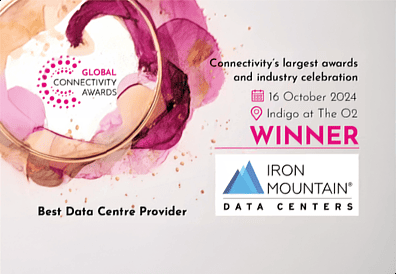Elevate the power of your work
Get a FREE consultation today!
Learn about the crucial role of data center sustainability in reducing carbon emissions, conserving energy, and creating a more sustainable future.

Delivering digital content and services without sacrificing our needs for healthy communities is what data center sustainability is all about.
At Iron Mountain Data Centers, we recognize the role we play as an important link in the supply chain that our customers rely on for their critical business functions. As our customers continue to set increasingly impactful goals, they are recognizing their footprint inside third party data centers as part of their own environmental performance.
Our industry leading commitments to carbon free energy, energy efficiency and low water consumption help our customers achieve their own environmental goals. Our goal is to be a force for good by modeling how organizations can be the solution to social and environmental challenges while delivering business positive outcomes.
Our data centers have been powered by 100 percent renewable energy since 2017, but that’s only part of our solution to building sustainable data centers.
Every day, we create more and more data in our work and daily lives, from the movies we stream to the cars we drive. This means that demand for data storage and processing is growing.
As data demand grows, this puts more energy demand on data centers, which consume a large amount of power. With the majority of the world’s electricity still generated from fossil fuels, this increasing electricity consumption can have an environmental impact.
Sustainable data center design meets the needs of growing data demand while minimizing environmental impact or even creating net-positive results. It uses a holistic approach to evaluate the environmental, economic, and social impact of a data center. The goal of these data center green initiatives is to create a facility that is energy efficient, environmentally responsible and resilient.
There are many benefits to using sustainable practices in data center design and operation. The first, of course, is to reduce environmental impact. In addition, sustainable data centers can also save money through reduced energy and water consumption and can improve the reliability and performance of the infrastructure.
While implementing sustainable practices in data center design requires significant investments in technology and infrastructure, as well as changes in operational practices, the long-term benefits of sustainable data centers make it worthwhile.
What goes into designing an eco-friendly data center?
By 2030, all of our colocation facilities worldwide will be Climate Neutral as part of our commitment as a signatory to the EU Climate Neutral Data Centre Pact. This will include the reduction of our overall emissions output to achieve net-zero, either through elimination of CO2 emissions or by purchasing credible carbon offset credits.
A carbon neutral data center implements key strategies to reduce its carbon footprint and offset any remaining emissions through various means, such as improving energy efficiency, investing in renewable energy projects, carbon-capture projects, or buying carbon credits. We have invested heavily in wind farms, and have the largest rooftop solar installation of any data center in the US at our New Jersey data center.
Data centers can offset their carbon emissions by purchasing carbon credits, which are a form of carbon offsetting. The credits are generated by projects that reduce, avoid, or sequester carbon emissions, such as renewable energy projects, reforestation, or carbon capture and storage.
To become carbon neutral, a data center must first measure its carbon emissions, and then put in place strategies to reduce them as much as possible. After that, any remaining emissions can be offset by purchasing carbon credits. In addition, data centers can also offset emissions indirectly through investments in clean energy projects or by purchasing renewable energy certificates (RECs).
It's important to note that, becoming carbon neutral doesn't mean the data center will not produce any carbon emissions, it means that the data center will produce no more carbon emissions than it can offset through carbon credits or other means. This is an important step of the journey while we continue to innovate carbon free solutions for difficult sources to decarbonize, like our need for diesel backup power generators that are necessary today for power resiliency.
There are different levels of data center certifications. BREEAM is the world’s leading science-based suite of validation and certification systems for sustainable built environment. Iron Mountain was the first company to construct a BREEAM design-certified data center in North America.
A LEED Gold data center is the highest level of certification that can be achieved under the LEED rating system for buildings. This type of facility has been designed, constructed, and operated to meet the highest standards of energy efficiency and environmental sustainability. This could include features such as energy-efficient cooling systems, use of renewable energy sources, and recycling of waste heat. Our data center in Boston is an example of a LEED Gold certified data center.
As a top 30 purchaser of green power in the US, we have built strong renewable energy capabilities and continue to emphasize the importance of carbon free energy on our path to net zero emissions.
In 2021, we set a goal to go beyond our existing practice of meeting our annual data center electricity volume with 100% renewable power. We are the only global colocation provider committed to matching each hour of data center electricity consumption with locally produced clean energy, fully decarbonizing our electricity consumption every hour of every day, everywhere.
Data center sustainability is a large part of that pledge. By 2025, Iron Mountain plans to have all new construction of multi-tenant data center facilities certified to the BREEAM Green Building Standard.
By 2030, all of our data centers worldwide will be Climate Neutral. Having carbon neutral data centers is consistent with our commitment as a signatory to the EU Climate Neutral Data Centre Pact.
We are founding signatories of the United Nations 24/7 Carbon Free Energy Compact and have signed The Climate Pledge™ - committing to achieve Net Zero emissions by 2040, 10 years ahead of the Paris Climate Accord.
We are committed to doing what’s right both for our customers and the environment. Working together, we can create a sustainable future.
Get a FREE consultation today!

